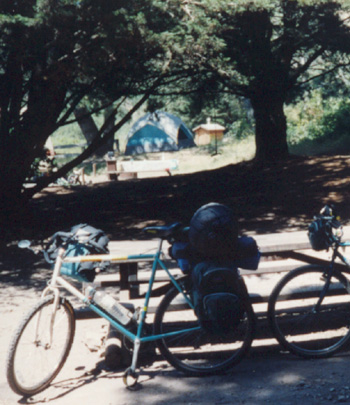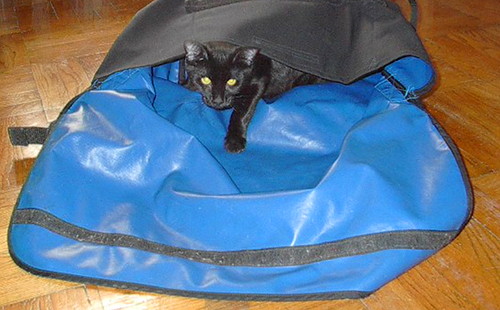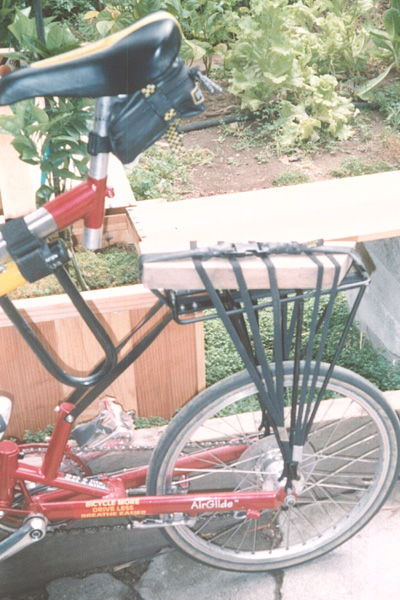Packs
Packs worn on the body are a drag for long rides, but ideal
for everyday use. They come in three basic varieties:
- A fanny or day pack, which puts the weight on the hips via
a wide belt, and may have a thin strap or two around the
shoulders to stabilize the bag.
- A messenger bag, which puts the weight on the shoulders
via a wide strap, and may have a second thin strap near
the hips to secure the bag.
- A curvilinear bag that conforms to various parts of the
body.
I use a Day Pack more than anything else.
Mountainsmith's "lumbar pack" is ideal for most of my daily
needs. It's big enough for magazines and file folders, and its
wide hip belt is very adjustable and thus very comfortable.
Mountainsmith designs bags to be extensible. You can attach
their smaller bags to this one, or you can attach it to their
larger bags (such as a full-sized backpack). For longer rides,
you can also tuck in the hip belt and other dangling straps and
attach the bag to the bike itself. For ecological reasons, I
like to use as little synthetic fabric as possible, and this
design allows me to combine just a few bags for a large variety
of uses.
 |
|
In this photo, I've
tucked in the hip belt and attached the lumbar pack to my
handlebars. Overland makes a smaller lumbar pack with a hip
belt that tucks in, and that's what's attached to the other
bike's handlebars. (These panniers are also made by Overland,
as described below.) |
|
My only complaint is that it's not waterproof in very heavy
rains. This bag would be vastly improved if it had a large
messenger-bag-style flap on it!
Modification: The retaining strap can be made more
comfortable if one end of it is tied to one of the bag's upper
loops, rather than to the buckle it's supposed to be attached
to.
 I use a Messenger Bag for larger loads and wetter
weather. I've got a very nice
Zo bag, handmade in San Francisco and sold mostly by word
of mouth to messengers (and patrons of a certain biker bar).
Since they're not so easy to get, some people imbue them with
a certain mystique -- as opposed to the bags made by
Timbuk2, which are pretty easy for anyone to obtain,
including the dreaded messenger wannabes!
I use a Messenger Bag for larger loads and wetter
weather. I've got a very nice
Zo bag, handmade in San Francisco and sold mostly by word
of mouth to messengers (and patrons of a certain biker bar).
Since they're not so easy to get, some people imbue them with
a certain mystique -- as opposed to the bags made by
Timbuk2, which are pretty easy for anyone to obtain,
including the dreaded messenger wannabes!
I chose the Zo bag for a different reason: it was made of
thicker, sturdier material, and I want my bags to last a long
time (again, for ecological reasons). Since then, though, I
won a very nice Timbuk2 bag at a benefit event, and am happy to
report that they're now making them thicker and sturdier than
they used to!
Patagonia has tried to trademark biker culture with something
called the "Critical Mass® Bag." They work to eco-market
things, but I found the first round of these bags to be nondurable
and flimsy. Pfui. (These, too, have since improved somewhat.)
The Curvilinear Bags are still evolving, but I
haven't yet seen one that I particularly like. Some are just
glorified backpacks, others are much better. (Incidentally,
in case you don't know, backpacks aren't good for biking with.
They raise your center of gravity too far, and interfere with
arm movement.)
Underseat Bag
An Underseat Bag will hold bare essentials such
as a patch kit, some lube and some cheap allen wrenches, I like
Pedro's
Blowout Bag, because it's made from recycled inner tubes!
(Alas, the older models were made almost entirely from recycled
rubber; the newer ones aren't.)
A Rack
A Rack is essential if you want to make everyday
use of your bike. Indeed, when I depict bicycles in my .sig
files, I always draw racks on them (there's one at the bottom of
this page). One of my bikes has a lightweight sturdy aluminum
rack made by Blackburn; the other has a heavier rack by Jandd
Mountaineering. The Jandd racks can carry quite a bit, and they
allow you to move your panniers back, away from your heels.
Bike Friday makes a great folding rack, but it won't fit
on most bike frames.
Modification: Many racks come with 3mm hex bolts.
Blackburn racks actually come with aluminum 3mm hex
bolts, which can be munged very easily. 4mm hex bolts are
sturdier, so I use those.
A Rack Strap is actually a set of elastic bands
made from synthetic material, which stretch across a rear rack
and are all attached by hooks or loops. The easiest one to find
in the U.S.A. is a model with two bands made by Blackburn. Bike
Friday has a better one with three bands. These are really
handy, but not very durable: they break if stretched too much,
or they lose their stretchiness in about a year. That's too
wasteful. I picked up a rack strap in Europe named "Quattro
Strong" with -- you guessed it -- four bands, which lasted a bit
longer.
Tube Ties are sections of used bicycle inner tubes
that are stapled to nylon snaps. You can use them instead of
rack straps to hold things onto your rear rack -- or anywhere
else they'll fit! I'm afraid they're not as gentle as rack
straps, but I use them as much as I can. They were made by
Resource Revival, a company that makes all sorts of
interesting things out of old bike parts, but tube ties aren't
even in their catalog anymore.
Modification: It's possible to make your own tube
ties with old inner tubes, nylon fasteners, and staples; or just
find an old inner tube and tie it into knots!
 |
|
Bike Friday's strap with triple bands is on the left,
and Blackburn's strap with double bands is on the right. A Tube Tie is
snapped on lengthwise. That's one secured chunk of wood!
The rear rack itself is a model made by Blackburn, and you
can see the Pedro's Blowout Bag under the seat. |
|
Panniers
Panniers (a.k.a. Saddlebags) are ideal for carrying
some things on your bike. They ride low, next to the wheels,
which is better for stability. Rear panniers will attach
readily to a rear rack. Look for a sturdy, truly waterproof
brand; I use Overlands but have had good luck borrowing other
brands. Panniers aren't secure from thieves, so I only use them
for long rides and tours, not for my everyday city riding.
Modification: Zipper tabs can make annoying clinking
noises, but they can be quieted by winding some twine around the
tab (hemp twine is best because it resists rot). Or the tabs
can be cut off entirely and replaced with pulls made of cloth or
twine. |


